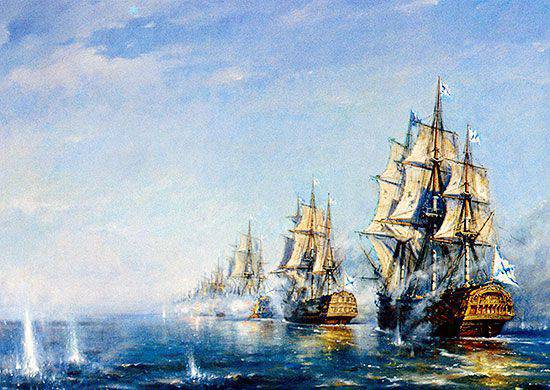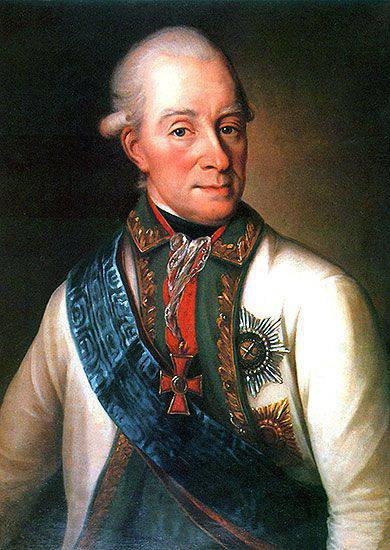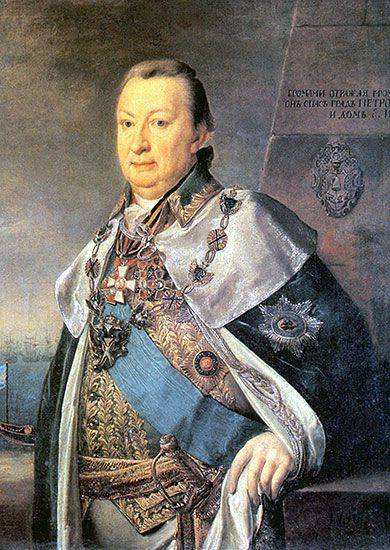Battle of Krasnogorsk 23– May 4 (June 3-4) 1790

1790 was a decisive year in the war between Russia and Sweden. It continued, but no radical change occurred, and the cabinet of Catherine II assigned a large role to the actions of her naval forces in the Baltic. On May 7, 1790, a squadron under the command of Vice Admiral A.I. entered the Kronstadt raid von Cruz assigned to reinforce the second part of the Baltic fleet, which was in Revel (Tallinn) together with the commander of the fleet, Admiral V.Ya. Chichagov. The Cruise squadron consisted of 17 battleships, including five 100-cannon ships - the Three Hierarchs, John the Baptist (Chesma), Nikolai the Miracle Worker, Two-on-Ten Apostles, and St. Prince Vladimir. "

11 May 1790, Cruise received a notification V.Ya. Chichagov, that at Cape Parklaut cruising ships found the Swedish fleet in the number of 28 pennants and the next day, 12 in May, Cruz went to sea. Admiral V.Ya. Chichagov with 12 battleships and 4 frigates out of Revel 16 in May and anchored off the island of Nargen, from where 19 numbers sent a report to the vice-president of the Admiralty Board IG Chernyshev: “The fleet of him (the Swede) is held according to news I received between Exholm and Steinshker. Although the wind is quite prosperous, if it were willing to follow the Kronstadt squadron, from which it must be concluded that it took measures to attack the first of our squadrons, which in its mind will seem. And as part of the fleet, which is with me, against the enemy forces, is incomparably less, then I cannot decide to fight with him with good luck, which is why we need to remove the Kronstadt part as much as possible, until we reach close distances between ourselves. ”[1 ]
Thus, initially the plans of the commander-in-chief did not include the attack of the enemy’s fleet, and he intended to evade battle, having decided to stand on anchors at Nargen. Squadron A.I. Cruise, meanwhile, due to strong headwinds stood at Krasnaya Gorka, and on May 20 was in 14 miles from Tolbukhina lighthouse. In the evening of May 21, in a quiet brahmin wind and clear sunny weather, the ship “John the Theologian” raised a signal that it sees the Swedish fleet approaching from the side of Seskar Island. The next day, 22 in May, Cruise's squadron was located 16 miles from Cescar, between Long Nose and Cape Stirsudden, ready for battle in the battle line (17 ships, 1 thousands of people) on the right tack. The Swedish fleet was in the wind.
The Swedish squadron under the command of the duke Charles Südermanland included 29 ships, 1 722 guns, 15 thousands of people. And the Swedish frigates of the 40-gun rank rose in line de battles along with the battleships and at any phase of the battle could replace the failed ship.

Military historian of the second half of the XIX century V.F. Golovachev wrote: “All our hopes were pinned on Cruise. He and his squadron had, if not to defeat the Duke of Sudermanland, then to fight to the last ship and to the last man, defending Kronstadt and the capital ”. Indeed, the Swedish fleet was superior in strength and strength to the Kronstadt squadron, and the Duke of Südermanland had every chance of breaking Cruise's squadron and forcing it to return to Kronstadt. In this case, a large rowing flotilla of the Swedes would have the opportunity to transport the troops and disembark it in the Oranienbaum area, which would then move by free way to Petersburg. Therefore, Admiral V.Ya. Chichagov, who was anchored to the island of Nargen with the rest of the fleet, needed to join up with Cruz, but the commander-in-chief did not.
Meanwhile, Vice-Admiral A.I. Cruise built ships in such a way that there were two 74-gun ships on the flanks; the third ships from the flanks were 100-cannon, then there were three 66- and 74-cannon, then, closer to the center - two 100- and two 74-cannon, and in the center of the line (cordabatalia) stood the flagship "John the Baptist" (100 guns). Behind the line was a detachment of vessels from three rowing and four sailing frigates under the command of F. Denison. A.I. Cruz ordered him to observe the course of the battle and, if necessary, reinforce the weak points in the line, and in case of its breakthrough, assist the most affected ships. In such a warrant, the Kronstadt squadron of the 17 battleships, stretching out to 4 - 5 miles, tacked across the Gulf of Finland.
On the eve of the battle, on May 22, with the onset of darkness, with the quietest wind, the sea remained calm. In the Russian squadron, there was a lively movement of the boats, which were carrying orders from the admiral, since it was difficult to recognize signals in the night. The enemy fleet was approximately four miles away. At dawn, the Swedes were in battle order warrants on the right tack in the line on the line stretched for about six miles; large frigates are several behind the ships at intervals. The wind remained the same - quiet, bram-like.
On Vice-Admiral Cruise's flagship, two signals were raised: “Correct the line”, “Rear ships to add sails”, and after that on all ships they put bramseli and bom-bramseli. The squadron in a checkerboard pattern on the right flank met the Swedes.
“23 May 1790 of the year from midnight. Poor weather, cloudy. The enemy fleet is visible under the wind. At the end of the 3 hour, we had a signal to attack the enemy with a rifle shot, and then a signal was made to attack the ariergadias. In 3 hours a signal is made to attack the avant-garde and cordebatal. We began to descend on the enemy line and the admiral ship.
In 4 hours, as they approached the enemy fleet, it turned out to be in the line of the 22 ships lying on the right tack. At the beginning of 5 hours, according to our avant-garde, from the enemy vice-admiral's ship began to produce the fiercest firing, for which we are responsible. ”
The Swedes delivered the main blow to the Russian avant-garde under the command of Vice Admiral Ya.F. Sukhotina. A squall of nuclei fell on the ships "Two-on-Ten Apostles", "John the Theologian" and "Victory". From the flagship 100-gun "Two-on-Ten Apostles" on the Swedish avant-garde fell back fire. Shortly after the start of the battle, Vice Admiral Ya.F. Sukhotin was seriously injured - his right leg was torn off by the core. In the logbook of his ship, "it is written that" by strong palboy, the two enemy ships lying against us harmed much of the ship's hull, and more rigging. " The shooting from the ship “was done with such success and sight, that the enemies from the ship were removed. After clearing the smoke, they saw that the ship of our John the Divine had the form of the stubby knocked down, and on the ship, John the Baptist, Krujes, the stump of [2]. Despite the loss of ranks, the flagship team did not leave the battlefield and continued to fight.
In the epicenter of the battle, besides the “Two-on-Ten Apostles”, there were two more 100-cannon - the ship of the commander of the vanguard Rear Admiral I.A. Povalyshyn of the "Three Hierarchs" and the commander of the squadron and the corpsic battalion of Vice-Admiral A.I. Cruise "John the Baptist." Gradually, the large Swedish frigates entered the formed intervals and took their places near the battleships.
As noted in the journals, 23 May was sunny and clear, but the battlefield was clouded with a wall of thick smoke, due to which the sun was not visible. Towards seven o'clock in the morning, the Swedes began to noticeably shy away from the battle and leave in the direction of Cescar. However, the ships of the center of the Russian line under the command of Admiral Cruise, in full smoke, with the help of tugboats, advanced behind the enemy and "strewed grapeshot". By eight o'clock in the morning the Swedish fleet finally left the battlefield.
The battle at Cape Stirsudden, better known as Krasnogorskoe, was won by the squadron of Admiral A.I. Cruise, since the enemy retreated. During a brief respite, Alexander Ivanovich on the boat inspected the ships and visited Admiral Sukhotin. Between the 10 and 11 hours of the morning, when the shroud of smoke gradually dissipated, the Swedish rowing flotilla in the number of 17 units appeared from the Bjork Islands, which opened fire after joining the fleet. In the journal “Two-on-Ten Apostles” it is written: “On the ship, the Baptist made a signal to the whole fleet of a preparatory man for battle. The Swedish fleet was built on the right tack line. At the end of the 12 hour, our fleet turned to the right tack, and on the ship the Baptist received a signal to all those going fordevint or backstay to put the ships into the tailgate on the right tack. And this signal was repeated on our own and on the ship of the Three Hierarchs, according to which the execution was repaired. ”
Vice-Admiral Cruise ordered F. Denison with a signal: "Frigates attack the enemy flotilla," and a squad of rowing frigates with oars went towards the Swedish skerry flotilla. The attack was made around 11 am, and the enemy's rowing ships, unable to withstand the battle, went under the protection of their ships.
May 23, at the beginning of the second hour of the day, the Swedish ship fleet resumed the attack on the Russian squadron. At short distances to him, in the sphere of rapid fire, were the ships of the Russian rearguard, and especially the cordebatalia with the flagship "John the Baptist." Admiral Cruz responded to enemy shots with intense fire from all the decks, ordering the rest of the ships to "close the line." Two 74-gun ships: "Great Sysoy" and "John the Theologian" did not continue to fight: the commander of the last I.M. Odintsov left the line and arbitrarily, without the admiral's permission, left the scene of the battle and went to Kronstadt on the pretext of repairing the ship. [3]
The battle lasted about an hour. At three o'clock in the afternoon the Swedes began to move away from the Russians, and after a quarter of an hour Cruz gave a signal: "Stop the battle." He intended to pursue the enemy, so he continued to move. At six o'clock in the afternoon, the Swedish avant-garde ships began to approach the Russian avant-garde with the clear intention to cut through the system. As the remaining ships approached, the entire Swedish fleet laid down a counter-tack along the Russian line, and then opened fire from close ranges. Having made the shooting, the Swedes, however, began to move away from the Russian squadron, and at nine o'clock in the evening there was complete calm. Cruz ordered to lie in the drift.
This ended the first stage of the battle. Its results are as follows: May 23 people from the Russian side were out of order, 340 killed and 89 injured; 217 man was killed by ripping his own guns. During the battle in the squadron Cruise spent 5 36 cores; two 008-gun ships were out of action. The losses of the Swedes amounted to 74 killed and 84 injured.
All night, from 23 to 24 in May, holes were fixed in both fleets, torn sails were replaced, and damaged masts and tops were replaced. Seriously injured Vice Admiral Ya.F. Sukhotin was transported to Kronstadt, but the flag on his ship remained raised, so that the Swedes could not notice the loss. He died in June of the same 1790 of the year.
24 May in the second hour of the afternoon the Swedish fleet resumed the attack; the fleets approached on the right tacks, and at the beginning of the fifth hour the duke of Sudermanland ordered to open fire on the Russian avant-garde. During the battle, two ships of the Russian rearguard - "St. Peter "and" Tsar Constantine "- did not manage to reduce the course and cope with the sails, and the first one came running onto the enemy ship, and the second - to the Three Hierarchs. As a result, the ships of the Russian rearguard lumped together.
This circumstance immediately took advantage of the Swedish commander in chief. Two of his ships and four large frigates rushed into the resulting interval between the last Russian ship and Stirsudden, intending to put their opponent in two fires. This maneuver was noticed by Admiral Cruz and ordered F. Denison to hurry with the detachment to the aid of the rear guard. At six o'clock in the afternoon, the Swedish vanguard and the corpsial battalion began to leave the scene of the battle, but a fierce battle took place between the two “Aeriergardies” that lasted for half an hour. Ships "St. Peter "and" Konstantin "managed to go through the fordewind and fired at the enemy a powerful suite of fire from the guns of the left sides, not previously involved in the battle. The Russian rearguard on time came to the aid of a detachment of frigates under the command of Franz Denison, and by eight o'clock in the evening the Swedish fleet retreated.
From the side of his flagship "John the Baptist" A.I. Cruz sent a report to the vice-president of the Admiralty Board, Count I.G. Chernyshev: “23 numbers I attacked the enemy and was attacked by this one. In both battles the enemy fleet was forced to retreat. The next day, that is, the numbers Duke decided to 24 the last and skillful strike assigned to me by the squadron to deliver. In 3 hours of the afternoon I attempted to use a clear trick. Dividing his fleet into two parts, I thought maybe the Duke, that I would order my squadron to strive for one part, while His Highness, however, circled around, would put me between two fires. But instead of going into the trick, I continued to be in the same position, until I saw the enemy going for taxation. Then, on a signal, a turn was made, obstructing the execution of the plan he intended. The enemy finally decided to end the battle on the 5 watch and was very far away [4].
24 and 25 May Cruz sent important reports to Catherine II, in which he wrote: “The troops of V.I.V. every day is notable for its jealousy, but without receiving benefits from Admiral Chichagov, it will come to weakening little by little from frequent alarms. For my part, I will drive to the last force of the enemy with all its excellent forces. To my surprise, I noticed with all the commanders of the ships that during the last battle, which was very close to the distance, the enemy fleet was often idle with its guns, fired, so that sometimes 3-x or 4-gunned by volley shots a lot if one with the core was ”[5].
In the intervals between battles, in addition to detailed reports to the Empress, Alexander Ivanovich sent brief reports to Count I.G. Chernyshev, and in one of them there are such lines: “It is strange and incomprehensible for me that the state. Admiral Chichagov this time does not come to my aid. It has been four days now that I have been fighting and thanking God for success, but the army is already becoming very burdensome. ”[6]
Indeed, the Revel squadron under the command of V.Ya. Chichagova as part of the 12 battleships and four frigates went to the connection with the Kronstadt 16 May, but all the time remained at Nargen.
During the two-day battle - 23 and 24 in May Cruise's squadron suffered losses: 102 man was killed, 263 was wounded. Thus ended the two-day battle of Stirsudden, called Krasnogorskoe, since in St. Petersburg shots could be heard from the side of Krasnaya Gorka.
The fleet of the Duke of Südermanland suffered significant material damage, the ships were damaged in the mast, and repairing the masts and the toggle in the sea, far from their ports, was not possible. In the course of the battle with the Russian squadron, which consisted of only 16 ships, the Swedes, despite their advantages, retreated several times and avoided battle. It is not difficult to imagine what their position could have been at the moment when 12 Russian ships would have come from the west, creating a real threat to them being caught in the crossfire of two Russian squadrons.
27 May 1790, Vice-Admiral A.I. Cruise reported to the Empress: “Having traveled with a squadron entrusted to me for the fleeing enemy and who was afraid to get between two fires, I trusted, that the duke is not a savior from great damage, or maybe from a perfect break. But to my surprise, instead of a locked enemy fleet, our Revel ships began to open. Admiral Chichagov wrote to me that the fog that had happened prevented him from seeing the enemy. I am compelled to confess to VIV that the departure of the enemy is very sensitive for me, and for all of my brave subordinates. Especially since, according to the news that came to me through skippers, the Swedes were in excessive despondency and were afraid of this inexpressible two-fire position, from which, one must think, fog alone could save the enemy who fought with me ”[7].
V.Ya. Chichagov did not realize the possibility of completely destroying the Swedish naval forces, rather exhausted and exhausted in a two-day battle. Soon there will be the last battle in the 1788 – 1790 Russian-Swedish war - Vyborg.
Information